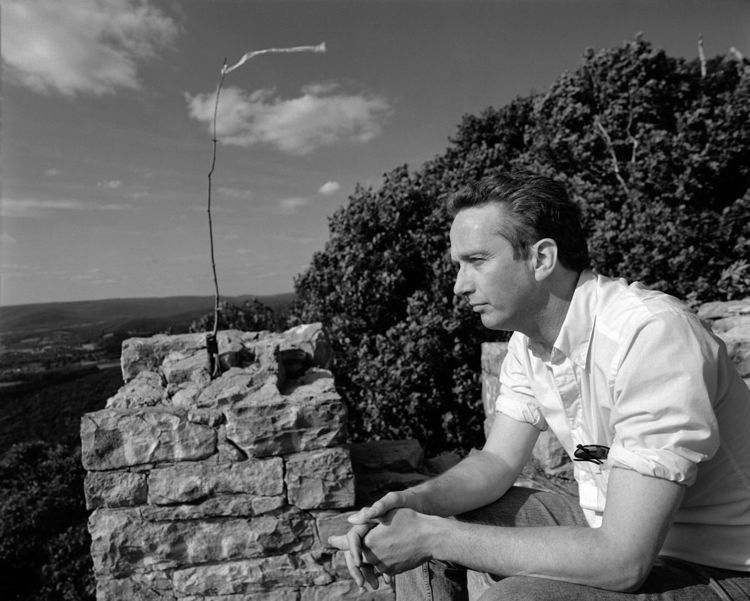Occupation Realist painter | Name John Grazier | |
 | ||
Born June 23, 1946 ( 1946-06-23 ) Born June 23, 1946 (age 76), Long Beach, New York, U.S. Died December 27, 2022 (aged 76) Shamokin, Pennsylvania, U.S. | ||
John Grazier (June 23, 1946 – December 27, 2022) was an American realist painter, working with India ink airbrush, pencil and oil paint. He was an American artist of the late-20th century known for his meticulous cross-hatching technique, skewed perspective, and a "dreamlike" representation of seemingly ordinary subjects, such as buses, coffee cups, office buildings, Victorian-style porches, and phone booths.
Contents
- Early life
- Methods
- Public Collections
- One Man Shows
- Greyhound Bus Terminal Project in Washington DC
- Exhibitions
- Death
- References

Early life
John Grazier was born in Long Beach, New York in 1946. His mother, Josephine Stine Grazier, attended Wellesley College and received an advanced degree at Harvard Graduate School. His father, back from World War II, owned the Bellevue Inn, a hotel in Delaware Water Gap, PA. He was only two when his father was diagnosed with cancer, went bankrupt and died. Several of his paintings were based on his lingering childhood memories of his father’s hotel. In 1968 he went to study at the Corcoran School of Art, and in 1971-72 he attended the Maryland Institute College of Art for a year on a full scholarship. He was awarded grants from the National Endowment for the Arts (1974) and the Pollock-Krasner Foundation. He also won first place in the 1975 Davidson National Print and Drawing Competition.
Methods
John Grazier started drawing images of coffee cups, buses, diners, tunnels and bridges at the beginning of his career in 1973.
As the Washington Post art critic Jo Ann Lewis wrote of John Grazier’s technique and subject matter (1980):
“…Silent, unpeopled interiors with empty coffee cups, overlooking a parking lot full of buses… He starts with an overall design in his head, draws in the basic lines with a ruler and then fills in the images with free-hand cross-hatching that retains the integrity of each line...”
During the 1990s, his subject matter evolved further, focusing on facades of Victorian architecture buildings, railed porches and balconies, windows, elaborate moldings (“Porch of the Bellevue Inn”, “The Silence of the Attic”), phones (“Sunset Strip”) and drawing persons (“The Carousel of Dreams” in 1996).
In 2001, Grazier started working in color using oil paints.
Public Collections
His works, “House on a Hill in a Dream” (1974) and “Memory of a Porch” (1976), are in the permanent collection of the Smithsonian American Art Museum. Another pencil drawing “End of the Line” (1980) is in the Art Institute of Chicago. “Breaking Up”(1976) and “Memory of a Porch (1975) are in the National Gallery of Art. The drawing “Passing Windows in Fall” is included in the Hechinger Collection “Tools as Art.” His works are also included in the permanent collections of the Library of Congress, the National Law Enforcement Museum in Washington, DC, and the Arkansas Arts Center. Two of his works, "Untitled" and "Rattling Windows", are included in the Pollock-Krasner Foundation image collection.
His works are also included in the following university collections: “City Lines” (1978) Rose Art Museum at Brandeis University (Waltham, Massachusetts), Davidson College (Davidson, North Carolina), Dartmouth College (Hanover, New Hampshire), University of Rochester (Rochester, New York), and Wellesley College (Wellesley, Massachusetts).
His work has been purchased by many law firms and corporations. His work are also in the private collections of Jim Lehrer, Truland Systems (“Night of the Shooting Stars”, “Dreams of the Wild Child”, “Burning Bush”, "The Prosperous House", "Whispers in the Attic", “Rebecca’s Doll House”), Nixon Peabody, Hogan & Hartson (“The Visitor”, currently Hogan Lovells), Owens Corning Corporation (Toledo, Ohio), Cyrus and Myrtle Katzen family (founders of the Katzen Arts Center at the American University in Washington, DC).
One-Man Shows
In 1974, he had his first one-man show at the Baltimore Museum of Art (Baltimore, Maryland, 1974, 22 pieces, including “Sound of the Wind.” David Tannous of Washington Star-News wrote of that show: “Grazier deals almost exclusively with sections of architectural exteriors…his perspective twists and changes unpredictably from point to point and in several planes at once… because of this, Grazier’s buildings stretch and pull in different directions…small delicate strokes of the pencil multiply into many-layered cross-hatchings…“
His other one-man shows include: the Fendrick Gallery (“Memories of a Lady’s Lace”, “Tall Building”), in Washington, DC (1975) Davidson College (Davidson, North Carolina) and the Lunn Gallery in Washington, DC, (1980, “End of the Line”, “Empty Vessels”).
In September–October 1991, John Grazier had a one-man show named “A Ticket to ...”at the Washington, DC’s Zenith Gallery. Featured pieces included large airbrush India ink paintings on paper: “Echoes: Coaches Idling”, “Junk Yard Dogs”, “You Can’t Go Home Again”, “The Children Who Would Gallop”, “House on a Hill in a Dream."
Greyhound Bus Terminal Project in Washington, DC
In a summer of 1990, Grazier had signed a $125,000 contract with the Canadian developer Manulife Real Estate to produce 18 black-and-white airbrush paintings for the Greyhound Bus Terminal lobby in Washington, D.C.. The restoration of the terminal was part of an agreement with Manulife and area preservationists to keep the 1930s Art Deco building by architect William S. Arrasmith at 1100 New York Ave., N.W. intact as a lobby-entrance to a 12-story office building going up behind it. Upon its reopening in 1991, the building’s lobby featured enlarged photographs of the original 18 paintings featuring buses, coffee cups, lonely cityscapes and Mount Rushmore reflected in a bus windshield.
Exhibitions
Grazier's work has been included in many gallery exhibitions, including the Davidson National Print and Drawing Competition, Middendorf/Lane Gallery (Washington, DC), Foundry Gallery (“25 Washington Artists: Realism and Representation, Washington, DC), Corcoran Gallery of Art (Washington, DC), a United States Information Agency Tour of the Middle East, The Mint Museum (North Carolina), Washington Project for the Arts Exhibition. His urban landscape “Memory of a Trombone” has been exhibited at the Brooklyn Museum of Art (American Drawing in Black and White: 1970-80, Brooklyn, New York in 1980). His works have also been exhibited at the Southeastern Center for Contemporary Art (North Carolina), the Tampa Museum of Art (Florida), the Farragut West branch of Citibank in Washington, DC (“Sunset Strip,” “Where the Children Will Play,” “The Silence of the Attic,” “The Sound of the Wind,” “The Toy Chair,” “The Carousel of Dreams”).
In 1990, John Grazier was one of only two living artists represented in a show at DC’s Adams-Davidson Gallery featuring “200 years of American Master Drawings.”
He currently lives and works in Shamokin, Pennsylvania.
Death
He was found dead in his home on December 28, 2022, and is believed to have suffered a fatal heart attack the day before.
